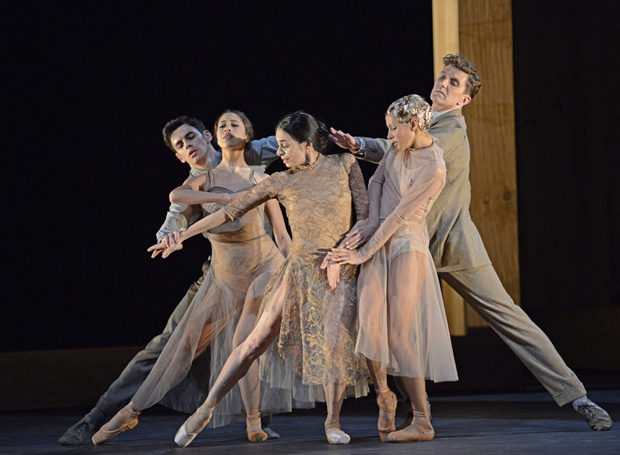
© Dave Morgan, courtesy the Royal Opera House. (Click image for larger version)
The Royal Ballet
Woolf Works
London, Royal Opera House
11 May 2015
Gallery of pictures by Dave Morgan
www.roh.org.uk
Woolf Works is a chimera, an illusory creation made up of disparate elements: part English ballet, part literary biography, part idiosyncratic Wayne McGregor writhing and theorising, set in a collaborative multi-media framework that only a subsidised theatre could afford. The programme booklet is a work of scholarship, with a pull-out section chronicling Virginia Woolf’s life and writings. It could serve as a crammer’s guide to Woolf studies; whether the ballet will encourage baffled spectators to read the novels on which it is based is anyone’s guess.
McGregor has responded to Woolf’s experimental, multi-faceted prose by juxtaposing different dance styles and conventions. He is not aiming for a linear narrative but for a collage of ideas and actions, sometimes taking place simultaneously. He doubles up characters, combining real-life people and fictional personages. Where Woolf was trying to capture in words how the mind works on many levels, he intends to arouse emotional states through the use of expressive bodies, music and visual images. Whether he succeeds depends on individual audience members’ reactions to the triptych of ballets: some will be moved, others indifferent or exasperated.
He has the great advantage of Alessandra Ferri as his central character, Woolf herself. Returning to the Royal Ballet and to performing at the age of 52, Ferri appears both a slender wraith and a formidable presence. In the opening act, based on the novel Mrs Dalloway, Ferri, as the writer and her alter ego, the fictional Mrs Dalloway, reflects on the past while experiencing the present – hence the title I now, I Then. If you know anything about Virginia Woolf, you know she’s doomed to die, committing suicide by drowning. So her recollections are tinged by melancholy and her dread of debilitating depression.

© Dave Morgan, courtesy the Royal Opera House. (Click image for larger version)
In several ways, this act takes place in familiar ballet territory: Ashton’s Enigma Variations, Tudor’s The Leaves Are Fading, MacMillan’s Anastasia. Virginia recalls her merry young self (Beatriz Stix-Brunell) and her first female infatuation (Francesca Hayward), both girls dancing charming Ashtonian steps. The men, older Gary Avis and younger Federico Bonelli, are gentlemanly partners, apart from some ugly splaying of Ferri’s legs in lifts. Why upend a meditative middle-aged woman?
Intercut with these wistful memories are scenes from another character’s life: Edward Watson is the shell-shocked soldier, Septimus Smith, haunted by his dead best friend, Evans (Tristan Dyer). Watson agonises as only he can, rejecting the consolation of Akane Takada as Smith’s worried wife. In the novel, Mrs Dalloway, who has no connection with Smith, learns of a soldier’s suicide with brief regret in the middle of a dinner party. Here, Ferri in a black coat teeters on the verge of madness with Watson, prefiguring her own suicide.

© Dave Morgan, courtesy the Royal Opera House. (Click image for larger version)
Max Richter’s plaintive score gives way to booming drums and crashes for the wartime action; sound effects by Chris Ekers are a reminder that life goes on, voices chattering, horses passing by, bells chiming. At the end of the act, Virginia is back in her garden with her solicitous husband before remaining alone, as at the start, with her memories. McGregor’s choreography has placed so much emphasis on the upper body that the repetitive arm-waving by all the characters becomes a distraction, like people who can’t stop gesticulating whenever they speak. Ferri does it beautifully, with hypersensitive intertwinings, but one starts longing for others to keep still.

© Dave Morgan, courtesy the Royal Opera House. (Click image for larger version)
The second act, Becomings, based on Orlando, is very much McGregor territory. It takes place in another universe, a sulphurous black space illumined by beams of light (spectacularly designed by Lucy Carter and the architectural firm We Not I). A dozen dancers pass through planes and bars of coloured light; caught in solos, duets, trios, they are often echoed by others half seen in the darkness. They all represent aspects of Orlando, as he/she changes sex and epochs in multiple dimensions. The formal ballet conventions of Act I have been replaced by contortionist shapes, spines flexing, legs flicking and flailing, arms grappling with partners, male and female.
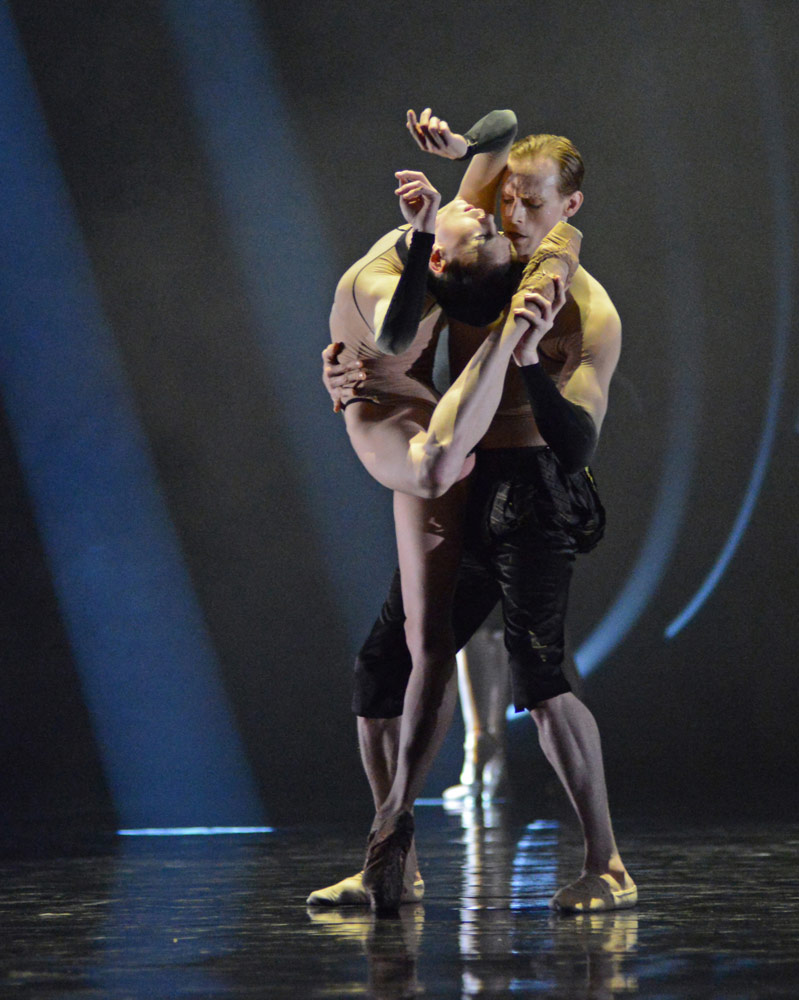
© Dave Morgan, courtesy the Royal Opera House. (Click image for larger version)
Natalia Osipova, Watson, Steven McRae and Sarah Lamb are the principal Orlandos, changing costumes from outlandishly golden Elizabethan dress and accessories to flesh-coloured leotards. The clothing makes little difference to the way they move, nor does the choreography distinguish between male and female convolutions: featured soloists all resemble McGregor clones. Yet the gist of Woolf’s experimental novel was her curiosity about the very different experiences of the sexes. This updated version of her early 20th century view of the world has moved on to unisex uniformity.
Outstanding among the supple suggestive bodies is Osipova, her long torso seeming infinitely pliable. She is adept at McGregor’s undulations, as she demonstrated in his Tetractys. Because her presence is so riveting, his lack of skill at managing exits becomes awkwardly obvious. He’s never been good at ‘disappearing’ dancers once their solos or pas de deux are over. Osipova is incapable of walking unobtrusively off stage.
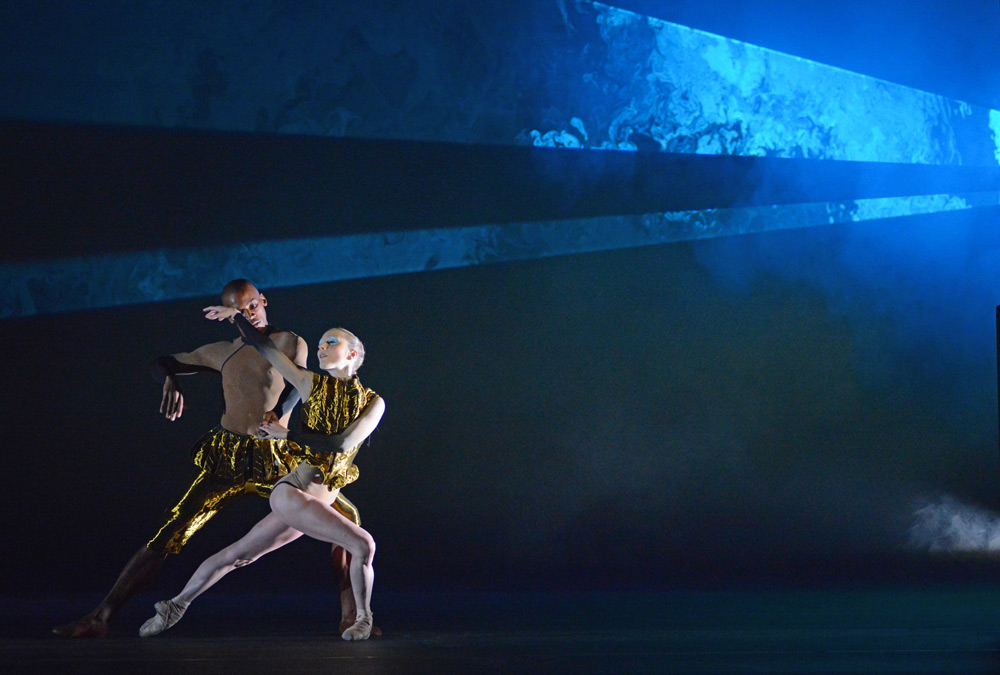
© Dave Morgan, courtesy the Royal Opera House. (Click image for larger version)
Becomings goes on too long, its busy finale for all six couples built up interminably by Richter’s cinematic sci-fi score. Though the cosmic lighting effects are stunning, they can’t make the dancers’ gyrations seem as fantastical as Woolf’s imaginative prose.
Ferri returns for the last act, Tuesday, based on The Waves. It opens with the voice of the actress Gillian Anderson reading Woolf’s final suicide note, addressed lovingly to her husband. In front of a slow-moving video of a turbulent sea, Ferri falls into the arms of Bonelli for an elegiac pas de deux. She seems weightless, already a ghost of her former self – Giselle, slipping from her lover’s grasp. A disembodied soprano voice laments above the repetitious phrasing of the Philip Glass-like score.

© Dave Morgan, courtesy the Royal Opera House. (Click image for larger version)
From under the back of the set, six children (Royal Ballet School students) rise up, playing with skipping ropes. They are characters from The Waves, which starts with their childhood, and the offspring of Virginia’s artist sister, Vanessa. Ferri watches longingly as Sarah Lamb’s Vanessa is entangled in the midst of her family – shades of the beach scene from Death in Venice.
A corps of dark-clad dancers, faces masked, emerges from under the sea to ebb and flow to Richter’s insistent music. Ferri is gradually absorbed into their surging patterns, manoeuvred into floating above their heads. But McGregor can’t get rid of them convincingly, shuffling backwards into the dark, in order to have Virginia stranded alone in a crucifix position. It’s obvious what he is trying to achieve as the inevitable conclusion to his triptych, but he is let down by the banality of the music: Richter is no Mahler.

© Dave Morgan, courtesy the Royal Opera House. (Click image for larger version)
A finer score might have assisted McGregor’s strivings to attain his ambition of making dance as abstract and profoundly moving as music. Woolf listened to Beethoven sonatas while writing The Waves, tuning her prose to be as rhythmical as poetry. McGregor has remarkable instruments in the Royal Ballet’s dancers but he’s no genius as a composer of ballets. Woolf Works obstinately remains a chimera, a clumsy three-act monster.















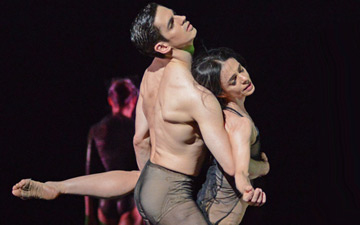
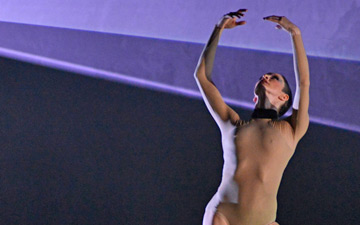
I’m so disappointed in Jann Parry’s review. Part of this is a personal subjective reaction because I really did admire both performances I saw and I really understood what MacGregor tried to do. The other reason for my disappointment is that I also admire Jann’s work – you’re a critic I respect – but I really think you’ve undervalued the piece. Greatly. And the final line is unnecessarily harsh based on observations I would seriously question.
This is a remarkably perceptive review, probably the best I’ve read so far. I guess it helps that I agree with every word, but Jann Parry puts it with forensic skill. Brava.
A second viewing of Woolf Works on 21 May confirmed my resistance to feeling manipulated into emotional responses by a cinematic score. Instead of being swept along, I watched how McGregor creates his effects, how he gets his remarkable dancers on and off stage, how he choreographs in verbs rather than sentences – there are no linking steps to reveal how rather than what a character is thinking or feeling. In the first act, he relies overmuch on gestures and mouthing: in the last act on clichés, ecstatic lifts and a surging corps. The Orlando middle act is as spectacular as a Cirque du Soleil show, with dancers disguised as acrobats.
Harsh to call the result a monster, but I meant it in the sense of a chimera – a creature made up of disparate parts.